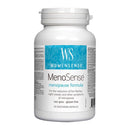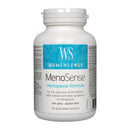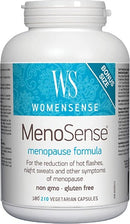MenNPN 80006313
Highlights
- For the reduction of hot flashes, night sweats, and other symptoms of menopause
- 90, 180, and 210 Vegetarian Capsules
The term menopause means one year with no menstrual cycle. Perimenopause is the 10–15 years leading up to menopause. Both times in a woman’s life can bring unwelcome symptoms. MenoSense contains natural ingredients to help relieve the symptoms associated with menopause and perimenopause. Black cohosh, chasteberry, gamma-oryzanol, hesperidin, and dong quai will help balance fluctuating hormone levels and ease the transition through menopause.
Overview
MenoSense is recommended by health care practitioners for the treatment of symptoms of menopause including hot flashes, night sweats, and more.
Recommended adult dose: 2 capsules at breakfast and 2 capsules at bedtime daily or as directed by a health care practitioner. Consult a health care practitioner for use beyond one year
Nutrition
Each 2 Vegetarian Capsules Contains
Medicinal Ingredients:
| Dong Quai Extract (Angelica sinensis) (root) (4:1 from 800 mg of dong quai) | 200 mg |
| Chasteberry Extract (Vitex agnus-castus) (0.6% aucubin) (fruit) (10:1 from 1600 mg of chasteberry) |
160 mg |
| Black Cohosh Extract (Actaea racemosa) (rhizome and root) (4 mg of triterpene glycosides measured as 27-deoxyactein) |
160 mg |
| Gamma-Oryzanol (Oryza sativa) (seed bran) | 150 mg |
| Hesperidin 40% (Citrus sinensis) (fruit) | 150 mg |
Non-medicinal Ingredients:
Vegetarian capsule (cellulose, purified water), microcrystalline cellulose, vegetable grade magnesium stearate (lubricant), silica.
Studies
References and Studies:
- Hirata, J.D., Swiersz, L.M., Zell, B., et al. (1997). Does dong quai have estrogenic effects in postmenopausal women? A double-blind, placebo-controlled trial. Fertility & Sterility, 68, 981-6.
- Kupfersztain, C., Rotem, C., Fagot, R., et al. (2003). The immediate effect of natural plant extract, Angelica sinensis and Matricaria chamomilla (Climex) for the treatment of hot flushes during menopause: A preliminary report. Clin Exp Obstet Gynecol, 30, 203-06.
- Stoltz, H. (1982). An alternative to treat menopausal complaints. Gynecology, 1, 14-16.
- Wuttke, W., Rauš, K., Gorkow, C. (2006). Efficacy and tolerability of the black cohosh (Actaea racemosa) ethanolic extract BNO 1055 on climacteric complaints: a double-blind, placebo- and conjugated estrogens-controlled study. Maturitas, 55, S83-S91.
- Warnecke, G. (1985). Influencing menopausal symptoms with a phytotherapeutic agent. Successful therapy with Cimicifuga mono-extract. Med Welt, 36, 871-74.
- Stoll, W. (1987). Phytopharmacon influences atrophic vaginal epithelium: double-blind study Cimicifuga vs. estrogenic substances. Therapeutikon, 1, 23-31.
- Düker, E., Kopanski, L., Jarry, H., et al. Effects of extracts from Cimicifuga racemosa on gonadotropin release in menopausal women and ovariectomized rats. Planta Med, 57, 420-24.
- Nappi, R.E., Malavasi, B., Brundu, B., et al. (2005). Efficacy of Cimicifuga racemosa on climacteric complaints: A randomized study versus low-dose transdermal estradiol. Gynecol Endocrinol, 20, 30-5.
- Wuttke, W., Seidlova-Wuttke, D., Gorkow, C. (2003). The Cimicifuga preparation BNO 1055 vs. conjugated estrogens in a double-blind placebo-controlled study: effects on menopause symptoms and bone markers. Maturitas, 44:S67-S77.
- Wuttke, W., Gorkow, C., Seildova-Wuttke, D. (2006). Effects of black cohosh (Cimicifuga racemosa) on bone turnover, vaginal mucosa, and various blood parameters in postmenopausal women: a double-blind, placebo-controlled, and conjugated estrogens-controlled study. Menopause, 13, 185-196.
- Rotem, C., Kaplan, B. (2007). Phyto-Female Complex for the relief of hot flushes, night sweats and quality of sleep: randomized, controlled, double-blind pilot study. Gynecol Endocrinol, 23, 117-22.
- Murase, Y., Iishima, H. (1963). Clinical studies of oral administration of gamma-oryzanol on climacteric complaints and its syndrome. Obstet Gynecol Prac, 12, 147-9.
- Ishihara, M. (1984). Effect of gamma-oryzanol on serum lipid peroxide levels and climacteric disturbances. Asia Oceania J Obstet Gynecol, 10, 317-23.
- Smith, C.J. (1964). Non-hormonal control of vaso-motor flushing in menopausal patients. Chicago Med, 67, 193-5.
Payment & Security
Your payment information is processed securely. We do not store credit card details nor have access to your credit card information.






